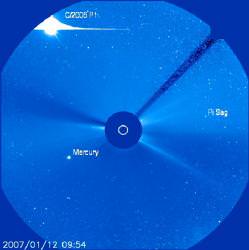 Okay, this is unprecedented. The really bright Comet McNaught that I mentioned a few days ago is now so bright that you can see it in the daytime. It’s extremely close to the Sun, so you need a way that you can block the glare of the Sun, but still see the sky.
Okay, this is unprecedented. The really bright Comet McNaught that I mentioned a few days ago is now so bright that you can see it in the daytime. It’s extremely close to the Sun, so you need a way that you can block the glare of the Sun, but still see the sky.
Find a building with a shadow that you can lurk in. Then look around the sky to see the comet. I can’t tell you which side of the Sun the comet will be on, because it all depends on where you are on the Earth, so try out a few locations. The comet should be about a fist-width’s distance (held up at arm’s length) away from the Sun, so it’ll be close.
The comet is now magnitude -5, making it the brightest since Ikeya-Seki in 1965. It it may get even brighter.
It’s totally cloudy here, so I haven’t tried it, but there’s a photograph on the Space Weather site.

At my age (78), BMI (46), and circumfrence (51″), my doc says I could implode into a black hole soon. Before that event, I’d like an answer to a question, if you can provide it.
Bright spot. Oklahoma City, 1500 hrs, Spring 1942, clear sky.
I could see a persistent, stationary point of light 10-15 degrees east, 5-10 degrees north of the zenith.
I have always assumed it was Venus, but for its ascension (I think it was too high; and too far east at that time of day).
Do you have any idea of what could have been bright enough for daytime viewing?
Do you think it was Venus? I’d like to know before I go.